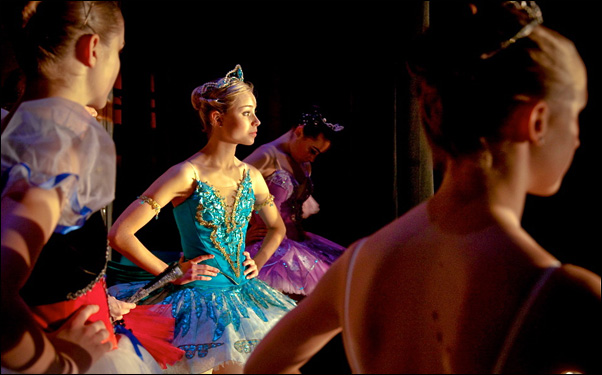Having trained in ballet when she was younger, Bess Kargman is used to making things that shouldn’t be possible appear effortless. A born storyteller, she graduated from Columbia’s Graduate School of Journalism and interned at NPR’s “Marketplace” only to be told by production companies that her experience in radio was actually counterintuitive to the career in documentary films she wanted to pursue, making her best opportunity at the height of the recession as a unpaid internship.
So it’s only natural that when Kargman took the initiative to make her first feature “First Position,” she would not just find a comfortable place to land in the world of ballet once more, but a grace in the tough circumstances her subjects have to endure en route to the Youth America Grand Prix, whether it’s as small and physical as a bleeding toe after standing en pointe all day or as large and intangible as the weight of a family’s hopes pinned on a dancer’s success to subsist.
“First Position” follows six dancers in pursuit of various achievements – from the older Joan Sebastian Zamora and Michaela DePrince, who hail from Colombia and Sierra Leone, respectively, who are seeking scholarships from prestigious ballet schools that would dramatically change their fortunes to the younger Aran Bell and Miko Fogarty, who are prodigies at the beginning of what promise to be bright futures. Yet while the film demonstrates a determination and elegance that are the hallmarks of ballet, Kargman aims to present an entirely different perspective of dance than the one we’ve come to expect. Surely, this is the first film on the subject to feature a montage of the dancers eating voraciously or seriously delve into the practical costs that go into grooming one for an inevitably short career.
However, it seems like there will be a long one ahead for Kargman after an award-studded festival run from Toronto to DOC NYC to Portland in recent months. Fortunately for us in the midst of it, the director took the time to talk about how she was drawn back to the artform, how being a ballerina once informed the film’s visual style and creating a film as vibrant and diverse as she believes the ballet world to really be.
Since you had trained as a dancer yourself, was this something that had always been in the back of your mind as a subject for a documentary?
I danced for a majority of my childhood and I knew as an adult that nothing like this existed. I was tired of waiting for someone else to make the film and by nothing like this existed, I don’t mean a competition documentary about ballet, but something that focuses as much on the backstage and home life of young dancers as much as the onstage aspects. I remember watching dance documentaries growing up and thinking yeah, their performances were beautiful and it was cool to see them rehearse, but I want to know if that guy’s going home and eating a cheeseburger. I want to know who he is as a human being and what drove him to want to become a dancer. And I thought a story like this where the cast is very diverse could also make for a really interesting way to provide intimate access into the world of ballet.
It’s diverse in a number of ways, not only in the racial makeup of the cast, but also in their age and socioeconomic background, which must’ve made it difficult to structure when the natural payoff is the competition aspect and yet they’re not really competing against each other.
One of the biggest challenges of doing a competition film is you could be risking the entire film on the last five minutes. It’s all about who wins and loses and those are factors you have no control over at all. That scared me. So I thought to myself if I don’t have any control over the semifinals or the finals or the last five minutes, I must shape the other 80 minutes in a way that’s so exciting and different and enthralling that even if the competition part did go as planned or even all the kids bombed, at least the lead up to the competition would’ve been really satisfying.
The other answer to your question is that ballet competitions are controversial and I know that and so do the organizers of the competition. They’re controversial [because] how can you judge art, right? What I liked about this competition was it wasn’t just about shiny medals. At the end of the day, if I haven’t become really invested in the characters, I don’t really care if they win as much. To have it be more about scholarships was a completely different type of competition film. Winning a shiny medal can’t always change your life, no matter what the competition is. Winning a scholarship really can transform a young dancer’s life and for that reason specifically, I thought that it was a unique competition to portray in a film.
To get such diversity as you have in your subjects, did you have certain things you were looking for?
I had certain requirements that actually had nothing to do with ballet. I wanted to show how diverse the ballet world is — not all ballet dancers are rich, not all boy ballet dancers are gay, not all female ballet dancers are anorexic. I thought wouldn’t it be fun and interesting and true to the ballet world to challenge those stereotypes?
The kids come from all around the world because there’s some amazing talent right now that’s coming out of Latin America; Asia is producing incredible dancers these days. I also wanted the ages to span all the age divisions and this is something that when I set out to make the film, a lot of well-intentioned mentors of mine very much criticized. They told me by not having the kids competing specifically against each other, i.e. by not having the dancers all in one age division, it’s not really that dramatic. And I thought that can’t be. They don’t have to be catty and fight and gossip behind each other’s back and necessarily competing against each other in order to have drama and excitement and tension.
How did you go about actually casting your subjects?
I knew I had to make this film because I was walking the street one day and there were these huge billboards for Youth America Grand Prix and it was the finals in 2009. I snuck into the theater – it was sold out – and I got the last seat in the back. And out on stage happened to walk the most splendid itty bitty baby ballerina that I had ever seen. I’d never seen such talent at the age of 11. She was graceful, artistic, strong and mature and she gave me goosebumps. I walked out and I said, “This is my film. I can do this because I have an area of expertise that hopefully will compensate for the fact I’ve never done this before.” I didn’t know who this girl was, but when they announced her name, it sounded half-Asian, so I went through the the hundreds and hundreds of competitor names [on the playbill] and I found 11-year-old Miko Fogarty. Then I noticed there was another Fogarty, Jules, and I said, “Oh my gosh, she has a brother?” This is too good to be true because you know interesting things can arise when you have a sibling pair. They were the first two people I cast.
I asked the [Youth America Grand Prix organizers] for a very big list of names to whittle down from 5000, and I went through the list. I ended up choosing some people also that weren’t even on the list. They were people who I saw dance and was really captivated by and the other dancers in the film who you meet [besides the central six], like the young lady showing you her disgusting feet and saying, “They’re nice in ballet shoes, but once you take them off, not so pretty” – these were all people that I also filmed because I wanted many voices in the movie.
Ultimately, I say there are six-and-a-half dancers and the reason why I say that was I didn’t “cast” Gaya [Bommer Yemini, an accomplished 11-year-old ballerina from Israel]. Aran cast her, [having] spotted how beautiful of a dancer she was, and knew he wanted to become friends with her. They formed this incredible friendship and through Aran, she became an integral part of the film. That was a filmmaker’s dream when this little puppy love story unfolds and I had nothing to do with that.
During another interview, you told an interesting story about shooting the Grand Prix in New York and mentioned a small detail that you had originally wanted a female cameraperson for the shoot, but couldn’t get one. Do you think either having a female perspective or your own background in dance would have an impact on what was captured on film?
It’s not that I couldn’t find a woman shooter, I couldn’t find one that was available. And the blessing in disguise is it forced me to start shooting. So when I was still fundraising and hadn’t yet hired my amazing director of photography [Nick Higgins], I was the one shooting. And what was wonderful about that was I could go into the women’s locker room and no one would feel self-conscious. When you see Rebecca upset in the locker room, that’s me shooting. But what’s fantastic about Nick Higgins is the dancers loved him because he skateboarded with them, he’s very funny…it ended up working just fine with the arrangement that I had.
One thing that’s very fascinating with the way dance is shot is that [many] cinematographers don’t realize the extremities are so crucial in ballet. If you don’t have elegant hands and a long neck and a beautiful pointe and long lines of the body, good luck making it as a dancer. These are so important and so frequently cinematographers love these closeups where all the limbs are cut off. That’s very unsatisfying for dancers and non-dancers to watch because it’s really exciting to see the whole body. So I made sure my director of photography and I [had what we] called the safe cam, so you always saw wide. Other camera angles would be extreme closeup. Then Nick Higgins always [was] backstage, right over the shoulder of the dancers, so you felt like you were right there. You could almost hear the kids’ heart beating right before they step out on stage. But I also believe the way dancing in this film is edited was very much informed by my ballet background and that’s something that I hope dancers and non-dancers alike will spot.
“First Position” opens in New York and Los Angeles on May 4th. It will be followed by a national rollout and a full schedule of theaters and dates can be found here.




